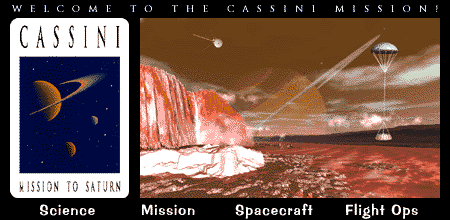
 |
 |
During the early 1980's, Voyager I and II collected information and photographs of the outer planets Jupiter, Saturn, Uranus and Neptune. The time of launch of these probes was crucial as these planets would not be so aligned for another 200 years. The Voyager Project Homepage contains excellent information about these planets. |
Compare and contrast the rings of Jupiter, Saturn, Uranus and Neptune. You may use the PDS Ring Nodes website or other references such as library books or the CD-ROM
|  |
||
|
The Voyagers returned spectular pictures of the moons of the outer planets. Calculate the percentage of rock and ice in these moons. You will want to read the background information on the teacher's page before you begin. |
|
|
The novel 2001:A Space Odyssey was written during the years 1964-1968. Its sequel was written in the early 80's after the Voyager missions had explored the outer planets. Arthur C. Clarke, the author, does extensive research when writing his books and the differences between the two novels are amazing. Believable science fiction often contains quite a bit of scientific fact. Read chapter 36 and 38 in 2010: Odyssey Two and write a comparison between the descriptions of Jupiter and its moons to that which is known today. Use the Voyager Jupiter Science Summary to help you get started. |
At the end of 2010: Odyssey Two, Jupiter becomes a sun. How does this happen in the novel? Compare the compositions of Jupiter and the Sun. What would be necessary for fusion to occur in Jupiter? |
Piece together evidence for the existence of ocean's on Europa, a moon of Jupiter. Do the "geology jigsaw puzzle" and summarize this activity. Turn in the answers to the"review questions" as well. |
 |
|
Mini activity to determine if ring plane crossings (when Saturn's rings cannot be observed from Earth even by the largest telescopes) are cyclical. Record your observations. |
|
||||
Mini-activity showing how stars can be seen through Saturn's rings. Record your observations. |
||
Make a timeline of the Cassini mission. Where is it now? Include as much information on the timeline as you can concerning where the spacecraft will be and what its objectives are. Build a model of the spacecraft. Write a description of each scientific instrument the spacecraft contains. | ||
|
Download of the 1/37th Cassini model for experienced modelers |
 |
For further activities on Saturn, you may look at the Cassini Educators Guide. Additional information about the Cassini Mission is available on the Cassini "Ways of Seeing " CD-Rom. | ||
   |